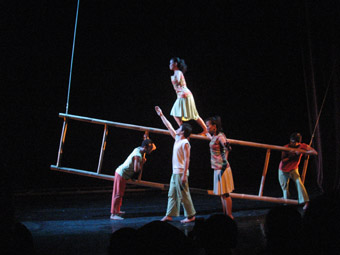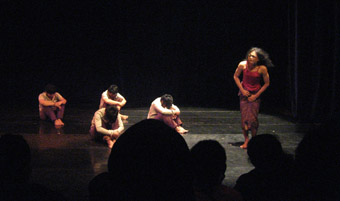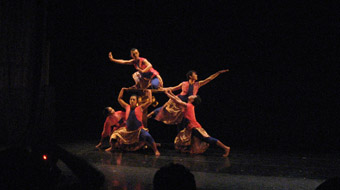 |
5,6,7,8 photo Phalla San |
Nur Sekreningsih Marsan’s 5,6,7,8 elaborates one person’s journey and their relationship with others. With ladders as the principal stage properties, the dancers are often placed in challenging circumstances. One part of the work requires two dancers to walk along the narrow length of the side of a ladder, the delicate balancing reflecting the difficulties faced in relationships.
Cekrek (Click) by Joko Sudibyo opens with a scene where a woman wearing a blue kebaya top and batik cloth sits down in the middle of a group in dim blue light. Her hair is pulled back and rolled into a big bun. It’s a look preferred by most Javanese mothers when posing for a family photo. Four young men wearing long sleeved white shirts stand before her. Slowly and gracefully, the woman stands. Gently moving to the right, she performs the subtle hand gesturing of Javanese dance. But as soon as she leave the stage, the four boys move about dynamically, the mood shifting from tradition to modernity.
This shift and its reverse occurs several times in Cekrek: in the next scene another man appears, bare-chested and wearing a batik sarong. He moves in traditional Javanese fashion with special precision and fluidity while the four boys circle around him. He then performs a duet with the woman in the blue kebaya before exiting. If she is an idealised mother the man appears to be a missing father figure.
 |
Cekrek photo Phalla San |
Near the end, the idealized mother reappears, putting an abrupt halt to a chaotic situation. The real mother contains herself. The four boys tuck in their shirts, poke each other as though wanting to show the mother who’s to blame, and solemnly form a line with their mother. The idealized mother slowly sits and pulls out a camera. Without being commanded they all smile comically and wave politiely as their picture is being taken. One big happy family.
Cekrek very simply suggested the importance of the mother in a family. Her nonchalant presence is crucial, creating harmony while her absence yields chaos—a belief firmly held by most Indonesian families. The successful fusion of traditional and modern movement and its simple imagery made the dance a delight to watch.
 |
Gayaku photo Phalla San |
GAYaku opens with three men and a woman seated in a circular formation beneath another man sitting on top of a round platform. Squatting cross-legged, he flexes his right arm, making a gestures like those of deities in Hindu temples, while the other dancers circle him.
Live gamelan playing thickens the traditional ambience, with a male singer chanting in Javanese “a woman should be with a man; how it would be when a man decided to pair with a man, and a woman with a woman?”
GAYaku depicts the joyous decision of the men to embrace their sexual identity. Four men gather again in a circle, this time wearing glittering bamboo hats commonly used as rice baskets. They shake their bodies coquettishly, while forming a circle facing each other. One gestures as if applying make-up, his other hand holding an imagined mirror.
The festivities move into over-the-top celebration as the dancers invade the auditorium, shaking their bottoms. This "We’re gay and we’re proud!" mentality reflects life in many big cities in Indonesia where more and more men and women daringly come out, 'boasting' their gayness.
The last two works in this program were Retorika Kerinduan by Santi Pratiwi and Bunglon by Serraimere Boogie. The first is about urbanization, and the yearning to return to village life, while the other elaborates on the ability to adapt. Bunglon involved Papuan costume and a merging of Javanese and Papuan movement.
Overall this showcase of works by emerging choreographers demonstrates the effectiveness of dance education in Indonesia. It is also refreshing to see that tradition plays an important part in the work—having strong roots is always a good place to start.
10th Indonesian Dance Festival, Emerging Choreographers: Cekrek choreographer Joko Sudibyo, music Preley Talaut; GAYaku, choreographer Shinta Maulita, music Munarno and Shinta Maulita, Teater Luwes, Taman Ismail Marzuki, Jakarta, June 16
Devi Fitria is a Jakarta-based journalist who works for the Indonesian art magazine ARTI and an online history magazine, HISTORIA: www.majalah-historia.com.
© Devi Fritrai; for permission to reproduce apply to [email protected]








 back
back